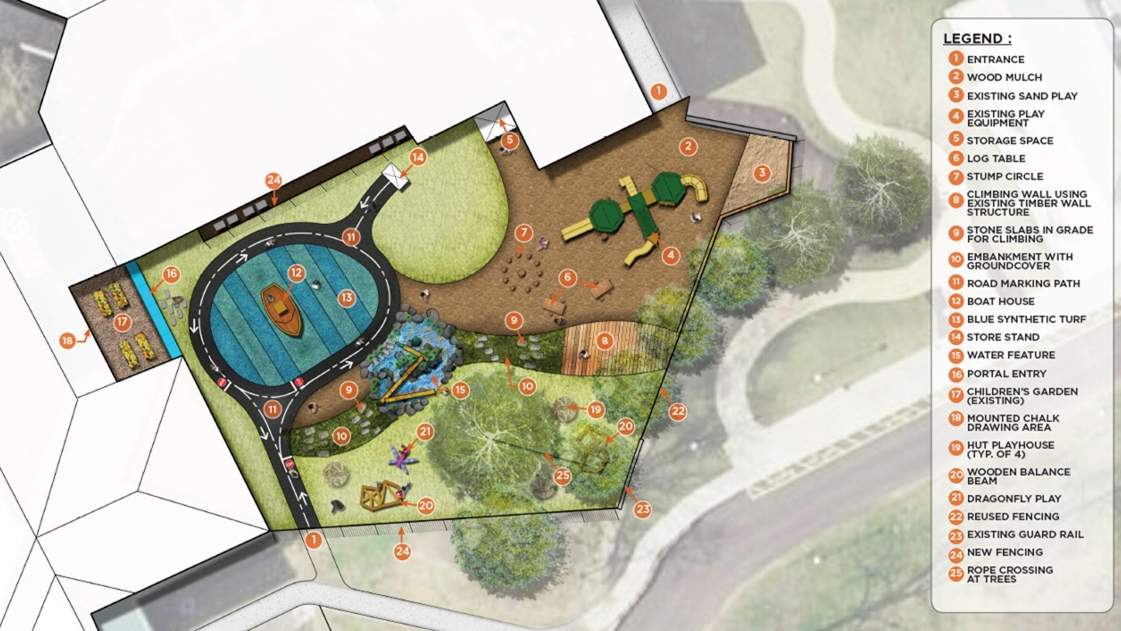Designing Inclusive Playgrounds for Children of All Abilities

When you think about a playground, it seems as simple as a handful of great slides, swings, and monkey bars. I know my personal favorite was a merry-go-round and how fast we could spin before flying off. But today, things are evolving. As designers, we’re beginning to work with clients to develop more inclusive playgrounds that meet the needs of all children.
Did you know that roughly 6.2% of children ages 5 to 15 (2.8 million kids) in the U.S. have disabilities? That can range from physical disabilities to cognitive and behavioral challenges such as autism and sensory processing disorders.
This topic is of particular interest to me. In 2012, my son was diagnosed with sensory processing disorder and classic autism at the age of 3. Personally, I’ve witnessed him react to certain elements in a playground both positively and negatively. This has driven my passion to create inclusive playgrounds.
It can be disheartening to see a child not feel welcome in a playground, especially when we know the value these spaces have in childhood development—from mental and physical to social and creative.
In order to design playgrounds that inspire and embrace children of all abilities, following are four tips we keep in mind when working with our clients.
-
Safety First:
First and foremost, keeping children safe is the number one priority. When designing playgrounds, we recommend creating fences to keep kids from wandering off, which is necessary for many special needs, in particular a child with autism. Now, we’re not talking about a chain link fence that feels like a cage. Fences can create fun, vibrant boundaries for kids if done right.
Keep in mind: a fence doesn’t necessarily need be connected all the way around the play space. Breaks in strategic locations can keep children safe while also allowing further exploration.
Interestingly, fences promote a feeling of independence. According to an article on Medium.com, a team of landscape architects conducted a simple study to observe any physical and psychological influences of having a fence around a playground. On playgrounds without fences, the children tended to gather around the teacher and were reluctant to stray far from her view. On playgrounds that were fenced in, however, they ran all around the entire playground, feeling more free to explore. The researchers concluded that with a boundary, in this case a fence, children felt more at ease to explore the space.
We also like to include soft surfaces to temper any potential falls. Rubber surfacing not only softens a fall, it allows wheelchairs to roll easily. Clenyjontri Park in McLean, Va., is a prime example. They built pathways between equipment that are wide and colorful, and the ground surfaces are non-slip and porous designed to provide a greater level of access for children.
-
Be Mindful of Space:
Children with sensory processing disorders or ADHD can suffer from sensory overload—everything is too loud and too close. This means they can easily can be overwhelmed in crowded spaces. Because of this, it’s important to provide adequate room between playground equipment.
Additionally, offering quiet areas of refuge—such as playhouses or treehouses—is a great way to keep children engaged while providing them a chance to be alone when desired.
Seattle Children's PlayGarden got really creative when designing unique spaces. For example, a vintage red truck (non-functioning, of course) was installed in the playground to provide children quiet places to get away. In fact, you can take a virtual tour of their playground for lots of ideas.
-
A Variety of Play & Education:
While socializing is a part of playing, it’s also important to provide opportunities for independent play. Chimes and labyrinths are great examples that also help appeal to children’s various senses. Distortion mirrors are an interesting way to encourage children to build a sense of self-hood.
Playgrounds aren’t always just about play… learning never stops. There are many fun ways to promote tactile learning but one I really like is water play. According to experts, young children gain physical learning through water play, such as precision in pouring, eye-hand coordination, and other skills. When children pick up buckets or other objects filled with water, they build muscle strength. And, it is multisensory for children who have vision and hearing impairments.
Creating an area with rocks where children can stack them up either building a mound or creating a dam for the water appeals to children who like to touch and feel different textures.
Another idea is to take a sandbox to the next level, turning it into a fossil dig so children have something to search for within the sand.
-
Stimulate Their Senses:
Lastly, there are many ways to engage children through a variety of senses. Musical instruments, life-size flowers in bright colors, kaleidoscopes, for instance, can all be embedded into a playground.
Case Study: The Columbus Academy Playground
We recently worked with the Columbus Academy, a PreK-12 school, to design a playground. I’m happy to share some of the unique elements we designed for the park. Special thanks to Kobolt Studios, which built many of the custom pieces.
While today’s playgrounds are certainly different than the playgrounds of my childhood, it’s still appropriate to include some of the go-to equipment like swings and slides. After all, these are still fun and relevant for kids. There are many other creative ways to make playgrounds appealing to all children. We hope these examples spark a few new ideas.







